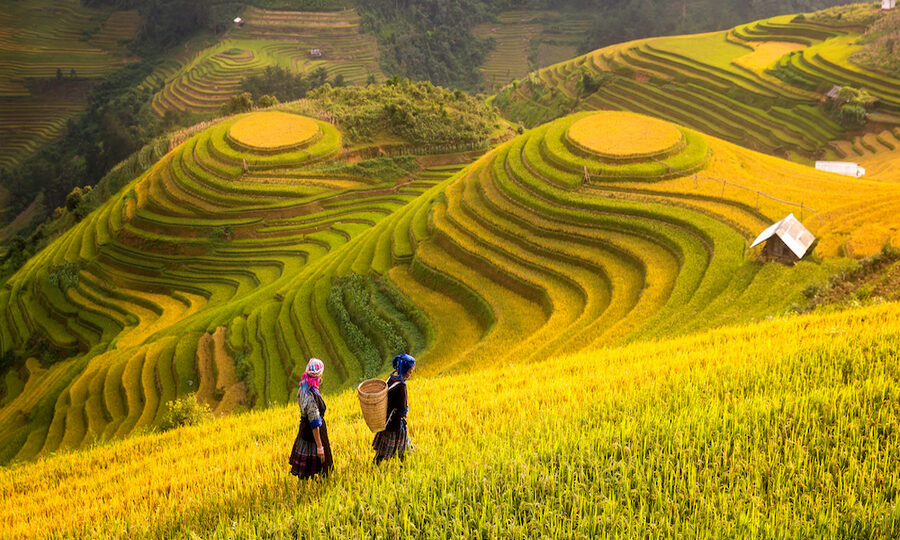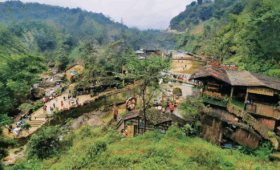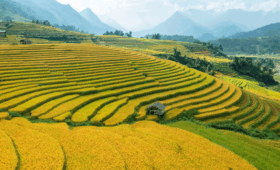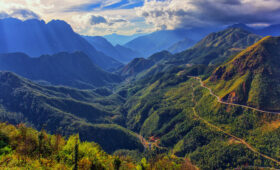1. Overview
Sapa, a highland town in the Northeast of Vietnam, about 350 km from Hanoi, is famous for its cool climate all year round and majestic mountain scenery. Located at an altitude of more than 1,500 m, Sapa offers the experience of “four seasons in one day”: cool mornings, warm sunny noons, cloudy afternoons, and cold winter nights.
Due to the mountainous terrain, the average annual temperature in Sapa is about 15.4°C (59.7°F); the highest is about 29.4°C (84.9°F) in July, and the lowest can be -3°C (26.6°F) in December. The coldest months last from December to March, sometimes with snowfall for 1–3 days, creating an extremely unique landscape.
Not only attractive for its nature and indigenous culture, Sapa also conquers tourists thanks to its pleasant climate. Choosing the best time to visit Sapa Vietnam, will help you fully enjoy the beauty here, from the brilliant peach blossoms in spring to the golden ripe rice season.
2. Best Time To Visit Sapa Vietnam: Experience The Full Beauty Of 4 Seasons
2.1. Spring (February – April) – Brilliant flowers
2.1.1. Characteristics of Sapa spring
Spring in Sapa lasts from February to April, bringing a picture of nature with brilliant flowers and an extremely pleasant climate. The mornings are chilly at about 12-15°C, and the afternoons are sunny with an average temperature of 18-20°C; the highest is about 22°C.
The air is fresh, with little rain, very suitable for visitors to walk among the hills of peach blossoms, plum blossoms, pear blossoms, yellow mustard flowers, and blooming rhododendrons. This is also the best time to visit Sapa Vietnam, attracting a large number of domestic and foreign tourists.
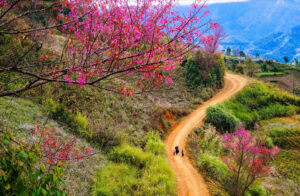
The beauty of Sapa spring with wild peach blossoms blooming throughout the villages and mountains. (Source: internet)
2.1.2. Memorable spring experiences in Sapa—The brilliant moments of the best time to visit Sapa Vietnam
Admire the brilliant flowers all over the mountains and forest:
From February to April, Sapa is covered in a colorful floral coat. In addition to the gentle pink cherry blossoms, you can also admire the pure white plum blossoms, white pear blossoms, bright red azaleas, and shimmering yellow canola flowers. The most beautiful flower viewing spots in spring in Sapa include:
- Cat Cat Village—famous for its yellow canola flowers and peach blossoms along the paths.
- Muong Hoa Valley—a brilliant spring picture with all kinds of flowers in bloom.
- The road to Fansipan peak is full of red, pink, and yellow rhododendrons blooming along the path.
Join the spring festival:
Participating in the spring festival in Sapa gives visitors the opportunity to immerse themselves in the bustling atmosphere of the beginning of the year and explore the cultural identity of ethnic groups through the Gau Tao festival of the Mong people, Roong Pooc of the Giay people, Dao dance, and the Tay people’s rice-farming festival. Don’t forget to visit spring markets such as Sa Pa, Bac Ha, and Coc Ly to enjoy traditional cuisine and experience the local lifestyle.
2.2. Summer (May–August)—Ideal place to escape the heat
2.2.1. Characteristics of Sapa Summer
Sapa in summer (May–August) has a much cooler climate than the plains, with an average temperature ranging from 17 to 23°C, clear skies, light sunshine, and occasional short showers. This is the best time to escape the sweltering heat of the city while admiring the lush green terraced fields and enjoying the fresh air of the Northwest mountains.
2.2.2. Experience Sapa Summer
Visitors can trek through villages and admire the majestic Silver Waterfall or the poetic Love Waterfall—the perfect starting point for a journey to explore Sapa. June-July is the season of ripe peaches and plums, offering the opportunity to enjoy delicious fresh fruit right in the garden. At the end of summer, the terraced fields begin to turn yellow, creating a beautiful scene for trekking and photography.

Sa Pa (Lao Cai) – June is the season of ripe plums. (Source: internet)
2.3. Autumn (September–November)—Golden rice season
2.3.1. Characteristics of Sapa autumn
Autumn (September–November) is the best time to visit Sapa Vietnam, with dry, fresh weather and temperatures of 14–21°C. The golden terraced fields under the autumn sun create a beautiful scene, attracting a large number of tourists.
2.3.2. Experience Sapa autumn
Autumn is the golden time for Sapa tourism in the ripe rice season, especially in Muong Hoa valley, Ta Van village, Lao Chai, or Ta Phin. Tourists can trek through the village, watching the golden sea of ripe rice interspersed with wooden roofs and winding streams.
In addition, the experience you should not miss this season is hunting Sapa clouds on Fansipan peak, Ham Rong mountain, or O Quy Ho pass, where white clouds roll like a river in the sky. At the end of the day, you can stay at a homestay with a view of the rice fields, enjoy highland cuisine, and visit Bac Ha market to fully experience the soul of Sapa.

Every November is a great time for tourists to hunt clouds on the top of Fasipan mountain, a spectacular sight of nature (Source: internet)
2.4. Winter (December–January)—Sapa in the snow and fog
2.4.1. Characteristics of Sapa winter
Traveling to Sapa in winter (December–January) brings visitors a unique experience in the high mountains of the Northwest. Daytime temperatures are only 3–10°C; at night it can drop to –5°C in high areas such as Fansipan, sometimes with snow or frost—a rare phenomenon in Vietnam. The cold air, fog, and white landscape turn Sapa into a miniature European winter painting.
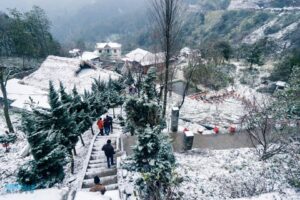
Coming to Sapa in December, visitors will feel the impressive cold air, floating in the clouds and white snow that few places in Vietnam have. (Source: internet)
2.4.2. Experience Sapa winter
Sapa snow hunting and frost viewing are experiences not to be missed in winter. High points such as Fansipan peak, O Quy Ho pass, Thac Bac, and Y Ty are considered “golden coordinates” to capture the moment of snowfall and white fog. The whole town is now immersed in a misty fog, creating a romantic and mysterious picture.
Conquering Fansipan—the roof of Indochina at 3,143 m high, visitors can trek or take the convenient cable car. From above, the majestic mountain scenery and fresh air make the journey more memorable. On the top, there is a sacred pagoda complex, such as Van Son Tra Quan, attracting many tourists.
- Round-trip cable car: Adults 32 USD (Monday – Friday & Sunday), 34 USD (weekends & holidays); children 22 USD.
- Round-trip Muong Hoa monorail: 8 USD/person.
- Funicular: Up 6 USD, down 5 USD.
- Combo cable car + buffet + monorail: 32 USD – 42 USD.
In winter, there is also the Sapa Winter Festival with cultural performances, parades, folk games, and fairs. This is also an opportunity to explore Cat Cat and Ta Phin villages, enjoy thang co, salmon hotpot, and dried buffalo meat, and learn about the lives of the H’Mong and Red Dao people.
3. Outstanding tourist seasons in Sapa
3.1. Golden harvest season—September to early October
Traveling to Sapa during harvest season is the most ideal time to admire the brilliant beauty of the golden rice fields winding along the mountain slopes. The scenery here is like a shimmering golden silk strip, stretching through the villages.
Hiking from Muong Hoa Valley to Ta Phin Village is a great way to enjoy the peaceful space and capture impressive photos. This is also the season of many traditional festivals and rituals, with unique music and folk dance performances, bringing a unique cultural experience to visitors.
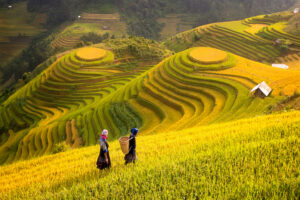
Going to Sapa in mid-September is the best time to see the ripe rice season. (Source: internet)
3.2. Flooding season – April to May
From April to early May, Sapa enters the flooding season, when the terraced fields are watered to prepare for sowing. At this time, the entire valley becomes a giant mirror, reflecting the blue sky and majestic mountains.
This is a “paradise” for those who love photography because of the unique lighting and color effects that are hard to find anywhere else. Traveling to Sapa during the flooding season not only brings poetic scenery but also captures the wonderful moments of nature and people here.

The unique beauty of Sa Pa terraced fields in the flooding season in May. (Source: internet).
3.3. Fansipan climbing season: March–April and September–October
Climbing Fansipan—”TheRoof of Indochina”—is chosen by many tourists in spring and autumn, when the temperature ranges from 15 to 20°C, the sky is clear, and there is little rain. Favorable weather conditions make the journey to conquer the peak safe and exciting. In addition to trekking, you can also choose the Fansipan cable car to save time and enjoy the full view of the Northwest mountains and forests.
4. So when is the best time to visit Sapa?
The best time to visit Sapa Vietnam is from March to May or from September to November, with mild, pleasant weather, clear blue skies, comfortable temperatures, and little rainfall. However, you can also visit Sapa at any time of the year. Depending on your interests, experiences, and arranged time, choose the right time to visit Sapa.
However, you should avoid visiting Sapa from June to early August because this is the beginning of the rainy season, even flash floods. Therefore, if you intend to visit Sapa at this time, you should monitor the weather and traffic situation in Sapa both before and after the trip.
5. Travel Tips for the Best Time to Visit Sapa, Vietnam
Book rooms and tickets early: Sapa is often fully booked during peak season, especially during autumn and festivals. You should book at least 1–2 months in advance to get a good price and convenient location.
Prepare suitable clothing: In winter, you need warm clothes, gloves, and woolen hats; in summer, it is light and airy. Don’t forget to wear trekking shoes for easy movement.
Respect local culture: When taking photos of people, ask for permission first. Avoid wearing revealing clothes when participating in festivals or entering people’s homes.
6. Conclusion
Choosing the best time to visit Sapa Vietnam depends on each tourist’s preferences, from the brilliant spring of peach blossoms, the cool summer, and the golden autumn to the snowy winter. Asia Luxury Travel is ready to accompany you on your journey to discover Sapa with the most complete and memorable experiences.
7. Contact :
Phone: +84 965 721 426
Email: sales@asialuxurytravels.com
Website: https://asialuxurytravels.com/
Address: No. 9, Alley 31/7, Phan Dinh Giot Street, Thanh Xuan, Hanoi

